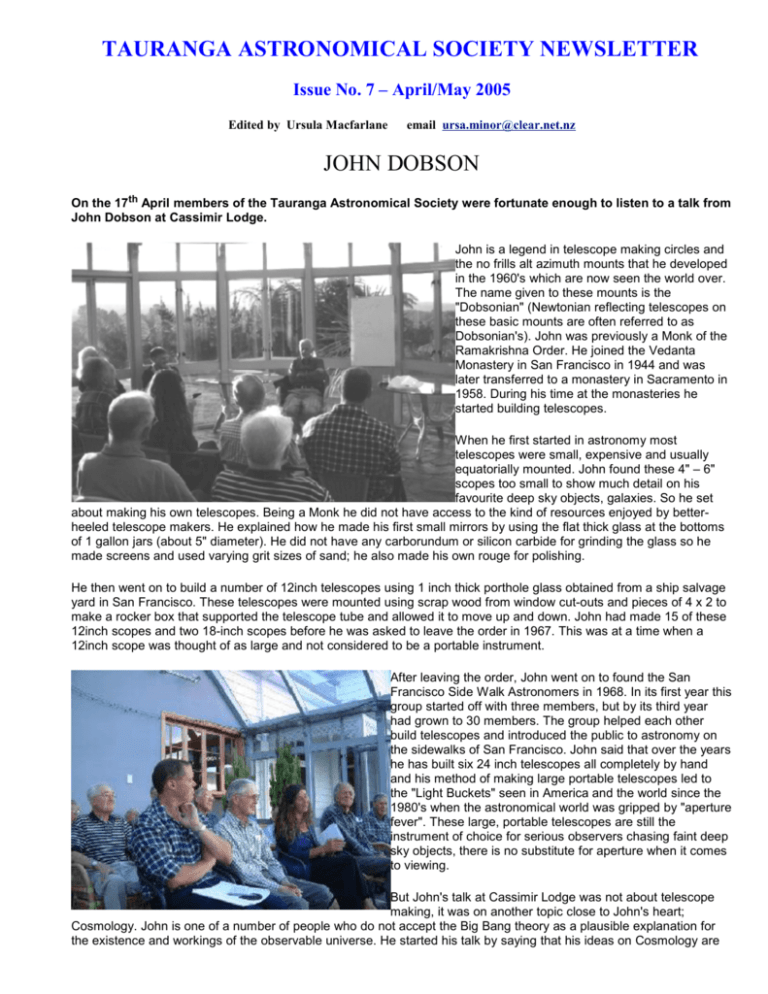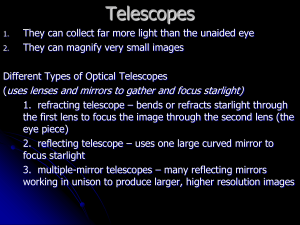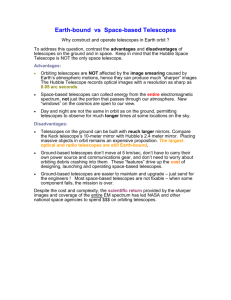7 April/May 2005 - Tauranga Astronomical Society
advertisement

TAURANGA ASTRONOMICAL SOCIETY NEWSLETTER Issue No. 7 – April/May 2005 Edited by Ursula Macfarlane email ursa.minor@clear.net.nz JOHN DOBSON On the 17th April members of the Tauranga Astronomical Society were fortunate enough to listen to a talk from John Dobson at Cassimir Lodge. John is a legend in telescope making circles and the no frills alt azimuth mounts that he developed in the 1960's which are now seen the world over. The name given to these mounts is the "Dobsonian" (Newtonian reflecting telescopes on these basic mounts are often referred to as Dobsonian's). John was previously a Monk of the Ramakrishna Order. He joined the Vedanta Monastery in San Francisco in 1944 and was later transferred to a monastery in Sacramento in 1958. During his time at the monasteries he started building telescopes. When he first started in astronomy most telescopes were small, expensive and usually equatorially mounted. John found these 4" – 6" scopes too small to show much detail on his favourite deep sky objects, galaxies. So he set about making his own telescopes. Being a Monk he did not have access to the kind of resources enjoyed by betterheeled telescope makers. He explained how he made his first small mirrors by using the flat thick glass at the bottoms of 1 gallon jars (about 5" diameter). He did not have any carborundum or silicon carbide for grinding the glass so he made screens and used varying grit sizes of sand; he also made his own rouge for polishing. He then went on to build a number of 12inch telescopes using 1 inch thick porthole glass obtained from a ship salvage yard in San Francisco. These telescopes were mounted using scrap wood from window cut-outs and pieces of 4 x 2 to make a rocker box that supported the telescope tube and allowed it to move up and down. John had made 15 of these 12inch scopes and two 18-inch scopes before he was asked to leave the order in 1967. This was at a time when a 12inch scope was thought of as large and not considered to be a portable instrument. After leaving the order, John went on to found the San Francisco Side Walk Astronomers in 1968. In its first year this group started off with three members, but by its third year had grown to 30 members. The group helped each other build telescopes and introduced the public to astronomy on the sidewalks of San Francisco. John said that over the years he has built six 24 inch telescopes all completely by hand and his method of making large portable telescopes led to the "Light Buckets" seen in America and the world since the 1980's when the astronomical world was gripped by "aperture fever". These large, portable telescopes are still the instrument of choice for serious observers chasing faint deep sky objects, there is no substitute for aperture when it comes to viewing. But John's talk at Cassimir Lodge was not about telescope making, it was on another topic close to John's heart; Cosmology. John is one of a number of people who do not accept the Big Bang theory as a plausible explanation for the existence and workings of the observable universe. He started his talk by saying that his ideas on Cosmology are limited to what can be observed, "if there is no observable evidence then leave it out". He also does not believe in the creationist theory (Big bang and mini Bang) "you can't get something out of nothing". During his talk John outlined his reasons for dissatisfaction with the current mainstream beliefs in Cosmology (that the universe was created in a hot Big Bang 12.5 – 13.5 billion years ago), he then went on to explain his beliefs on how things worked. He was quick to point out that there is no point discrediting the status quo if you can offer nothing to replace it with. John also told us of his belief in a recycling universe. This differs from the currently accepted view that the universe is expanding and will continue to do so until the last star fades to black and the universe will be a cold dark nothingness. John stated that material is recycled back into the universe once particles lose all their energy at extreme red shift, the evidence for this he states is the lyman alpha forest observable in the spectrum of distant quasars when analysed through a spectroscope. The lyman alpha forest is the spectral lines for hydrogen that are exhibited in the spectrum of some quasars. These lines are seen faintly throughout the spectrum. This shows that the light from the quasar has passed through clouds of hydrogen on its journey from its source to our earth. If these clouds were not present the hydrogen would be evident only in the light from the quasar (assuming that hydrogen is present in the quasar to begin with) as a single line rather than the "forest" of lines exhibited. This shows that there is a considerable amount of free hydrogen in the universe which John maintains should not be there if the Big Bang holds true. This free hydrogen is seen to be evidence of recycling; atoms that have lost their energy "tunnel" back into the universe as free hydrogen which is then available to form new stars and galaxies. His talk was highlighted with tales of his past exploits, the concept that the universe may be more conceptual than actual, and stories of discussions with many interesting and knowledgeable people. At the conclusion of his talk John spent another half hour fielding questions from the audience. His talk was well presented and appreciated by all those who were present. Personally it was great to meet someone who has contributed so much to Amateur Telescope making and to hear his views on the universe that he has spent so much time observing and introducing others too. Andrew Walker April 2005 Here are a few comments from other people in the New Zealand astronomy community who have also attended John’s talks…. Just got back from seeing John in Hamilton. Wonderfully entertaining evening - many thanks to all concerned. Regarding John's cosmology model... This was my first exposure to it. I had suspected his views might be unorthodox but I wasn't expecting anything quite so far out of left field. I thought it was interesting and to a lay person had some merit. I was particularly impressed when he claimed his model predicted background microwave radiation better than the Big Bang. Dave. (?) To be blunt I found his ideas on cosmology not well based on science as I understand it. I'll grant he was entertaining but not because he imparted any knowlege to me. I did not like the way he put incorrect statements into the mouths of cosmologists to rubbish their ideas. As an example, it is not true that "big bang theory requires the background radiation to be ten times higher than observed". As I understand it, the background radiation temperature depends only on how much space-time has expanded since the big bang and the early temperature at which those photons appeared. Mark Cannell, Auckland. John visited the Auckland Stardome last night to a fairly packed room. He talked, firstly about his early days buying four tonnes of porthole glass, the starting of the Sidewalk Astronomers and their exploits. He then got onto his favourite topic; cosmology. It was a fascinatingly entertaining talk from this man with his own special charm. I hope that I have his vigour at that age. Dave Moorhouse, Auckland. For what it's worth, I've been augmenting the information on the Wikipedia page about John Dobson after his visit, over at http://en.wikipedia.org/wiki/John_Dobson If anyone feels the incentive to correct anything that's there or update it with things they remember, the page is editable by anyone. (Note that wikipedia policy sides with editors who take a neutral point of view when writing.) Mike McGavin, Wellington. Speaking on behalf of our Society, I’d like to thank the organisers, in particular Mike Belcher who brought John and Graeme down from Auckland to be with us here at Cassimir Lodge. Everyone was in agreement that John was a most mesmerising speaker, and gave us plenty of food for thought. So, next time we go downtown to the Strand in Tauranga to take astronomy to the public, who’s coming to join us?? Ursula, Tauranga. www.sidewalkastronomers.com The Hubble Space Telescope was 15 years old in April Space Shuttle DISCOVERY astronauts released the school-bus-size telescope into Earth orbit in April 1990. Despite controversy about its future and aging parts, the instrument continues to add to its archive of more than 700,000 images. • Star Party News Selwyn Ridge Primary School On the evening of April 1st , Les Smith with the 10 inch Dobsonian, Jim Barrowclough with the 8 inch Schmidt Cassegrain and Graeme Mills with his smaller telescope met at the Selwyn Ridge primary school at Welcome Bay, Tauranga for a Star Party which was a part of a concentrated Astronomy and Science saturation by the school. They had earlier seen the wonderful shows presented by Gloria Witherford from Auckland with her inflatable Planetarium, and the evening was divided into ten separate stations of which our telescopes were just one. Some of the rest were viewing one of our DVDs, another was a sort of anti gravity device with yet another just lying on a tarpaulin out in the open under the stars to see what they could and were rewarded with the constellations and some shooting stars. The 150 children were in groups of 15 and rotating around the 10 stations. For our part we managed, in spite of encroaching cloud, to show all the children the planets Saturn and Jupiter and also the moon plus a little extra for some more of the fortunate people. We appreciated the politeness of the children who thanked us for showing them such wonderful sights. After 5 - 5½ hours out under the night sky we felt as the children did that they had enjoyed a wonderful and instructive evening. Some days later we three were rewarded with many appreciative letters and cards from happy students. It makes it all worthwhile. Rudolph Steiner School One week later in the evening of April 8th, Les and I took the two Society telescopes out to the Rudolf Steiner school also at Welcome Bay and managed to show all the senior pupils the two planets, Saturn and Jupiter before persistent cloud terminated the viewing. We adjourned to a nearby classroom and ran an informative discussion on elementary astronomy with many questions after. During the evening Andrew Walker turned up with his telescope as well. Unfortunately the moon rising was too late on this occasion so we may go back there again as it would be great for the children to view it through telescopes. All in all it was another successful Star Party but with a smaller number of children. Birthday Party…….. Meanwhile, as a double up on April 1st, Ursula was in the middle of Memorial Park showing a small group of children the night sky. The occasion was for a 9th birthday party, and the children enjoyed the sights of Jupiter, Saturn, omega Centaurii, 47 Tuc, and the Jewel Box through the 6" dobsonian. We all had a go at finding stars just using our hands and talking about distances, degrees, and brightness of different objects, and for those who had to wait to look through the telescope there was a playground to run about in. All the children had varying degrees of knowledge, but hopefully they all went away with more. Thank you to Sandra French for her donation to the Society, and also for the birthday cake. Thanks…………… To our newsletter contributors this time round……Andrew Walker and Jim Barrowclough. Also thank you to those who kindly offered donations to the Society. If anyone wants to give a talk about anything astronomical, please tell one of the committee members and we’ll help you organise it. Contributions to the newsletter most welcome ! email Ursula on ursa.minor@clear.net.nz






